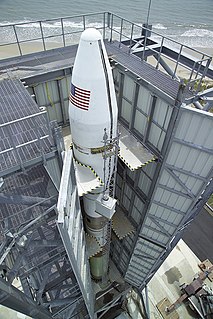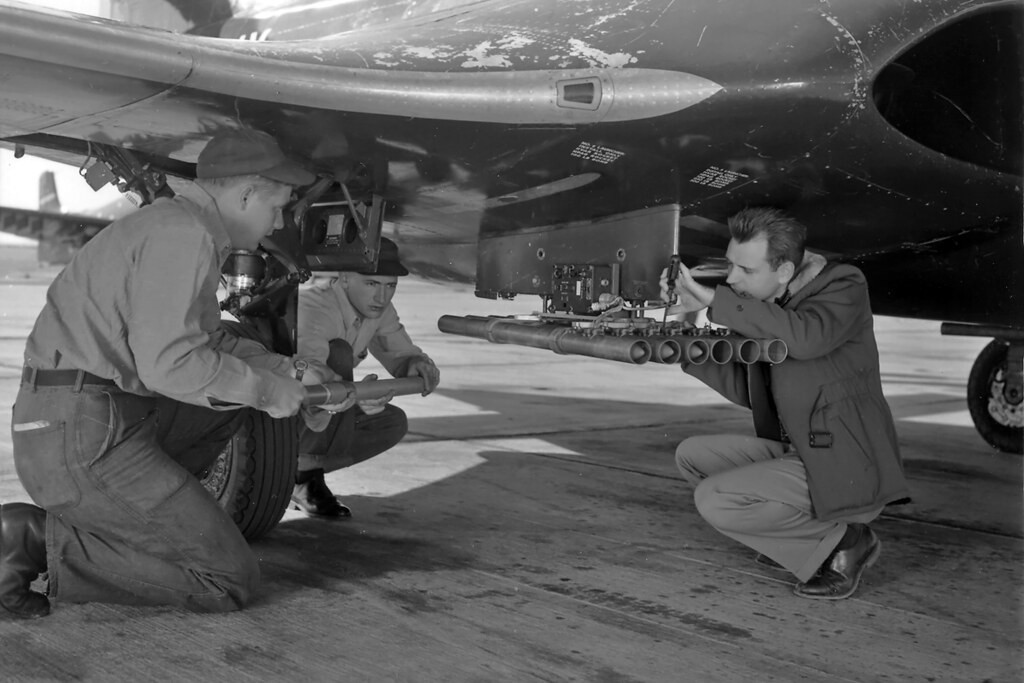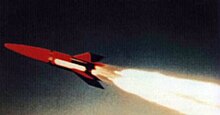
The Thor-Able was an American expendable launch system and sounding rocket used for a series of re-entry vehicle tests and satellite launches between 1958 and 1960. It was a two-stage rocket,consisting of a Thor IRBM as a first stage and a Vanguard-derived Able second stage. On some flights,an Altair solid rocket motor was added as a third stage. It was a member of the Thor family and an early predecessor of the Delta.

The Scout family of rockets were American launch vehicles designed to place small satellites into orbit around the Earth. The Scout multistage rocket was the first orbital launch vehicle to be entirely composed of solid fuel stages. It was also the only vehicle of that type until the successful launch of the Japanese Lambda 4S in 1970.

The Pacific Spaceport Complex –Alaska (PSCA),formerly known as the Kodiak Launch Complex (KLC),is a dual-use commercial and military spaceport for sub-orbital and orbital launch vehicles. The facility is owned and operated by the Alaska Aerospace Corporation,a public corporation of the State of Alaska,and is located on Kodiak Island in Alaska.

The Minotaur is a family of United States solid fuel launch vehicles derived from converted Minuteman and Peacekeeper intercontinental ballistic missiles (ICBM). They are built by Northrop Grumman via contract with the Air Force Space and Missile Systems Center's Space Development and Test Directorate (SMC/SD) as part of the Air Force's Rocket Systems Launch Program which converts retired Intercontinental Ballistic Missiles into space and test launch systems for U.S. government agencies.

The ASM-135 ASAT is an air-launched anti-satellite multistage missile that was developed by Ling-Temco-Vought's LTV Aerospace division. The ASM-135 was carried exclusively by United States Air Force (USAF) F-15 Eagle fighter aircraft.

This comparison of orbital launch systems lists the attributes of all individual rocket configurations designed to reach orbit. A first list contains rockets that are currently operational or in development;a second list includes all retired rockets. For the simple list of all conventional launcher families,see:Comparison of orbital launchers families. For the list of predominantly solid-fueled orbital launch systems,see:Comparison of solid-fueled orbital launch systems.

P78-1 or Solwind was a United States satellite launched aboard an Atlas F rocket from Vandenberg Air Force Base in California on February 24,1979. The satellite's mission was extended by several weeks,so that it operated until it was destroyed in orbit on September 13,1985,to test the ASM-135 ASAT anti-satellite missile.

The NOTS-EV-2 Caleb,also known as NOTS-500,Hi-Hoe and SIP was an expendable launch system,which was later used as a sounding rocket and prototype anti-satellite weapon. It was developed by the United States Navy's Naval Ordnance Test Station (NOTS) as a follow-up to the NOTS-EV-1 Pilot,which had been abandoned following ten launches officially classified as failed missions. Two were launched in July and October 1960,before the cancellation of the project. Following cancellation,two leftover Calebs were used in the Satellite Interceptor Program (SIP),while three more were used as sounding rockets,under the designation Hi-Hoe. These derivatives flew until July 1962,when the Hi-Hoe made its final flight.

Scout X-1 was an American expendable launch system and sounding rocket which was flown seven times between August 1960 and October 1961. Four orbital and three suborbital launches were made,with four of the launches resulting in failures.
Scout X-1A was an American sounding rocket which was flown in 1962. It was a five-stage derivative of the earlier Scout X-1,with an uprated first stage,and a NOTS-17 upper stage.

The Bold Orion missile,also known as Weapons System 199B (WS-199B),was a prototype air-launched ballistic missile (ALBM) developed by Martin Aircraft during the 1950s. Developed in both one- and two-stage designs,the missile was moderately successful in testing,and helped pave the way for development of the GAM-87 Skybolt ALBM. In addition,the Bold Orion was used in early anti-satellite weapons testing,performing the first interception of a satellite by a missile.

The Bombardment Aircraft Rocket,also known as BOAR,the Bureau of Ordnance Aircraft Rocket,and officially as the 30.5-Inch Rocket,Mark 1,Mod 0,was an unguided air-to-surface rocket developed by the United States Navy's Naval Ordnance Test Station during the 1950s. Intended to provide a standoff nuclear capability for carrier-based aircraft,the rocket entered operational service in 1956,remaining in service until 1963.

The RAM,also known as the 6.5-Inch Anti-Tank Aircraft Rocket or ATAR,was an air-to-ground rocket used by the United States Navy during the Korean War. Developed rapidly,the rocket proved successful but was phased out shortly after the end of the conflict.

The Gimlet was an unguided air-to-air and air-to-surface rocket developed by the United States Navy during the early 1950s. Although it proved successful in testing and was ordered into large-scale production,the arrival of the guided missile as a practical and reliable weapon resulted in the cancellation of the Gimlet rocket in 1957.
The Diamondback was a proposed nuclear-armed air-to-air missile studied by the United States Navy's Naval Ordnance Test Station during the 1950s. Intended as an enlarged,nuclear-armed version of the successful Sidewinder missile,Diamondback did not progress beyond the study stage.

This article documents notable spaceflight events during the year 2019.

Notable spaceflight activities in 2017 included the maiden flight of India's Geosynchronous Satellite Launch Vehicle Mark III on 5 June and the first suborbital test of Rocket Lab's Electron rocket,inaugurating the Mahia spaceport in New Zealand. The rocket is named for its innovative Rutherford engine which feeds propellants via battery-powered electric motors instead of the usual gas generator and turbopumps.

This article lists achieved spaceflight events in 2018. For the first time since 1990,more than 100 orbital launches were performed globally.

Jaguar was a three-stage sounding rocket developed by the United States Air Force in the early 1960s. Designed for air launch to allow soundings from remote areas without infrastructure,it was only launched twice before the project was abandoned.

















